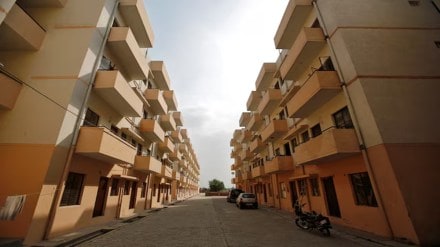Conventional wisdom says a cut in interest rates should be a big booster for affordable housing as the segment is highly rate-sensitive. But the reality may be different.
That’s because of poor connectivity and lack of social infrastructure in the areas where affordable housing projects can come up. Take Shankar Dube, 54, who works as a driver in Mumbai’s Breach Candy area, regrets that he sold his 200 sq ft hutment in Dadar and shifted to Dahanu near Mumbai in a one -bedroom apartment of 400 sq ft two years ago.
“We have to travel five kilometres to see a doctor and go to the next town to see a dentist,” Dube said. If that is not enough, he has to travel two-and-a-half-to-three hours one way from Dahanu to Breach Candy. “I am thinking of quitting the job and going back to my native place as it is becoming very difficult,” Dube said.
Amit Kumar Sinha, managing director and CEO at Mahindra Lifespace Developers, part of the Mahindra Group, said affordable housing demand has faced location and connectivity challenges. “To make the economics work, developers move to the outskirts of city limits. However, these locations are not well connected,” Sinha said, adding that there is no social infra for families to live and primary breadwinner to commute to job-centres.
Mahindra Lifespaces recently said it would discontinue affordable housing after completing its current affordable housing projects in FY29 and focus on premium housing.
“Affordable housing projects have not done well for us,” Sinha said in a recent investor call. The company currently has affordable housing projects under the Mahindra Happinest brand in Palghar and Kalyan near Mumbai, as well as in Chennai.
Big realtors have already made affordable housing a no-entry zone. While Mahindra Lifespaces plans to discontinue affordable housing, others such as Tata Housing, Prestige Estates and Shapoorji Pallonji have exited the space already due to high costs and lower margins.
Experts say the term affordable housing itself is confusing. For, what is affordable in Mumbai is, for example, premium property in a city like Kolkata.
Anarock Property Consultants defines the segment as houses that are priced less than Rs 40 lakh. Their share in overall housing sales in the top seven cities came down to 19% in 2024 from 38% in 2019. A possibility of interest rate coming down after the Reserve Bank of India’s rate actions is not going to mean much for buyers in this segment.
Additionally, developers have been losing interest in such projects due to lower margins and rising costs. Margins in affordable housing are between 10 and 15% as compared to 30-40 % in premium and luxury projects.
Besides connectivity and social infra, land should come at a subsidised rate for such projects, said Sriram Mahadevan, joint CEO, Shapoorji Pallonji Real Estate, and MD, Joyville Shapoorji Housing.
“Land should be given under cross-subsidy model where states should say take land and build homes just like slum rehabilitation projects in Mumbai,” Mahadevan said.
Though Joyville, a JV between Shapoorji Pallonji, Actis (earlier Standard Chartered Private Equity) and IFC, started off with affordable housing, it later changed its positioning to “aspirational mid-income and premium housing” brand .
Joyville started its first project in Howrah, near Kolkata, in 2016 and sold units of 500 sq ft at Rs 20-22 lakh apiece; today they start at Rs 40 lakh. A 3 BHK apartment sells for Rs 55 -60 lakh as against Rs 45 lakh when first conceived.
Irfan Razack, chairman and managing director at Prestige Estates Projects, said high interest rates have definitely increased the burden on the customer and has been one big reasons for affordable housing sales not picking up. “However, it is not the only reason. There is a lack of supply from quality developers in affordable housing space because of multiple other factors such as unavailability of low-cost FSI and increased construction costs,” Razack said .
FSI refers to floor space index which means permissible construction on a plot of land.
Affordable housing sales can only pick up when there is a right product available at a right price at a habitable location for the desired customer segment, Razack said.
Prestige Estates, which had set up a venture for affordable housing with HDFC Capital, abandoned its plans after the initial project, as it felt margins were thin.
Amit Bhagat, co-founder, MD and chief executive officer at ASK Property Fund, agrees with Razack. “High land prices, increase in prices in last four years and the increased focus of a majority of developers on the upper mid segment/ luxury housing are the reason for the not-so-healthy absorption for affordable housing,” he said.
Public private participation on government land and making affordable housing mandatory as percentage of every project will be the best way forward, Bhagat said.
Anuj Puri , chairman of Anarock, said: “Affordable housing is no longer very attractive for end-users and investors. Those who are at all able to leverage their budgets now tend to look for mid-range homes which also have better resale potential,” he said.
